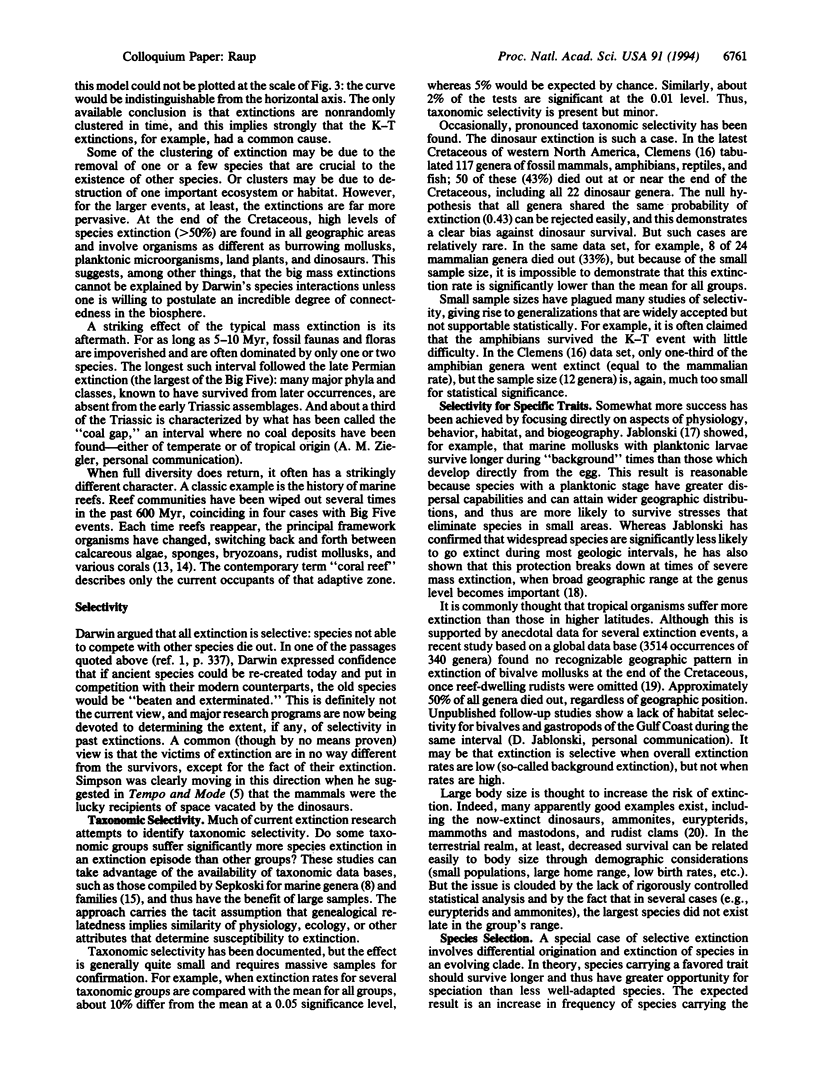Abstract
The extinction of species is not normally considered an important element of neodarwinian theory, in contrast to the opposite phenomenon, speciation. This is surprising in view of the special importance Darwin attached to extinction, and because the number of species extinctions in the history of life is almost the same as the number of originations; present-day biodiversity is the result of a trivial surplus of originations, cumulated over millions of years. For an evolutionary biologist to ignore extinction is probably as foolhardy as for a demographer to ignore mortality. The past decade has seen a resurgence of interest in extinction, yet research on the topic is still at a reconnaissance level, and our present understanding of its role in evolution is weak. Despite uncertainties, extinction probably contains three important elements. (i) For geographically widespread species, extinction is likely only if the killing stress is one so rare as to be beyond the experience of the species, and thus outside the reach of natural selection. (ii) The largest mass extinctions produce major restructuring of the biosphere wherein some successful groups are eliminated, allowing previously minor groups to expand and diversify. (iii) Except for a few cases, there is little evidence that extinction is selective in the positive sense argued by Darwin. It has generally been impossible to predict, before the fact, which species will be victims of an extinction event.
Full text
PDF





Selected References
These references are in PubMed. This may not be the complete list of references from this article.
- Alvarez L. W., Alvarez W., Asaro F., Michel H. V. Extraterrestrial cause for the cretaceous-tertiary extinction. Science. 1980 Jun 6;208(4448):1095–1108. doi: 10.1126/science.208.4448.1095. [DOI] [PubMed] [Google Scholar]
- Dodson P. Counting dinosaurs: how many kinds were there? Proc Natl Acad Sci U S A. 1990 Oct;87(19):7608–7612. doi: 10.1073/pnas.87.19.7608. [DOI] [PMC free article] [PubMed] [Google Scholar]
- Jablonski D. Background and mass extinctions: the alternation of macroevolutionary regimes. Science. 1986 Jan 10;231(4734):129–133. doi: 10.1126/science.231.4734.129. [DOI] [PubMed] [Google Scholar]
- Jablonski D. Extinctions: a paleontological perspective. Science. 1991 Aug 16;253(5021):754–757. doi: 10.1126/science.253.5021.754. [DOI] [PubMed] [Google Scholar]
- Raup D. M. A kill curve for Phanerozoic marine species. Paleobiology. 1991;17(1):37–48. doi: 10.1017/s0094837300010332. [DOI] [PubMed] [Google Scholar]
- Raup D. M. Extinction from a paleontological perspective. Eur Rev. 1993;1(3):207–216. doi: 10.1017/s1062798700000582. [DOI] [PubMed] [Google Scholar]
- Raup D. M., Jablonski D. Geography of end-Cretaceous marine bivalve extinctions. Science. 1993 May 14;260:971–973. doi: 10.1126/science.11537491. [DOI] [PubMed] [Google Scholar]
- Raup D. M. Large-body impact and extinction in the Phanerozoic. Paleobiology. 1992 Winter;18(1):80–88. doi: 10.1017/s0094837300012227. [DOI] [PubMed] [Google Scholar]
- Sepkoski J. J., Jr A compendium of fossil marine animal families, 2nd edition. Contrib Biol Geol. 1992 Mar 1;83:1–156. [PubMed] [Google Scholar]
- Sepkoski J. J., Jr Periodicity in extinction and the problem of catastrophism in the history of life. J Geol Soc London. 1989;146:7–19. doi: 10.1144/gsjgs.146.1.0007. [DOI] [PubMed] [Google Scholar]
- Sheehan P. M., Fastovsky D. E., Hoffmann R. G., Berghaus C. B., Gabriel D. L. Sudden extinction of the dinosaurs: latest Cretaceous, upper Great Plains, USA. Science. 1991 Nov 8;254(5033):835–839. doi: 10.1126/science.11536489. [DOI] [PubMed] [Google Scholar]


